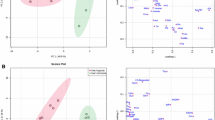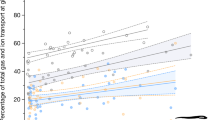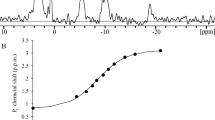Abstract
THE Congo eel (Amphiuma means) is a primitive salamander that respires through its lungs, gills and integument. It lives in swamps, ditches and rice fields in the south-eastern USA. When pools and swamps become stagnant and water levels drop, Amphiuma will burrow and hibernate in the mud. In this letter we report that when organic phosphate cofactors are low or absent, as might be true during hibernation, the haemoglobin of this amphibian has unusual properties which may help the animal to extract oxygen from a low pH environment. The molecular adaptation exhibited by Amphiuma haemoglobin is a pH dependence of oxygen binding that is reversed relative to that of most haemoglobins. Low pH brings about a large increase in the oxygen affinity of stripped Amphiuma haemoglobin. This negative Bohr effect indicates that protons are bound as oxygen is bound. This is in contrast to the release of protons that usually accompanies oxygenation. New Bohr groups must be present in this amphibian haemoglobin, or the normal Bohr groups must be drastically modified. From a physiological viewpoint it is of interest that the Bohr effect in vitro is subject to regulation by organic phosphate cofactors.
This is a preview of subscription content, access via your institution
Access options
Subscribe to this journal
Receive 51 print issues and online access
$199.00 per year
only $3.90 per issue
Buy this article
- Purchase on Springer Link
- Instant access to full article PDF
Prices may be subject to local taxes which are calculated during checkout
Similar content being viewed by others
References
Antonini, E., and Brunori, M., Haemoglobin and Myoglobin in their Reactions with Ligands (North-Holland, Amsterdam and London, 1971).
Riggs, A. F., and Wolback, R. A., J. gen. Physiol., 39, 585–605 (1956).
Bonaventura, C., Sullivan, B., and Bonaventura, J., J. biol. Chem., 249, 3768–3775 (1974).
Perutz, M. F., Nature, 228, 726–739 (1970).
Kilmartin, J. V., and Hewitt, J. A., Cold Spring Harbor Symp. quant. Biol., 36, 311–314 (1971).
Bonaventura, J., Bonaventura, C., Brunori, M., Giardina, B., Antonini, E., Bossa, F., and Wyman, J., J. molec. Biol., 82, 499–511 (1974).
Antonini, E., Wyman, J., Zito, R., Rossi-Fanelli, A., and Caputo, A., J. biol. Chem., 236, 60–63 (1961).
Sullivan, B., Chemical Zool., 9, ch. 5, 77–122 (1974).
Watt, K. W. K., and Riggs, A., J. biol. Chem., 250, 5934–5944 (1975).
Author information
Authors and Affiliations
Rights and permissions
About this article
Cite this article
BONAVENTURA, C., SULLIVAN, B., BONAVENTURA, J. et al. Anion modulation of the negative Bohr effect of haemoglobin from a primitive amphibian. Nature 265, 474–476 (1977). https://doi.org/10.1038/265474a0
Received:
Accepted:
Published:
Issue Date:
DOI: https://doi.org/10.1038/265474a0
Comments
By submitting a comment you agree to abide by our Terms and Community Guidelines. If you find something abusive or that does not comply with our terms or guidelines please flag it as inappropriate.



